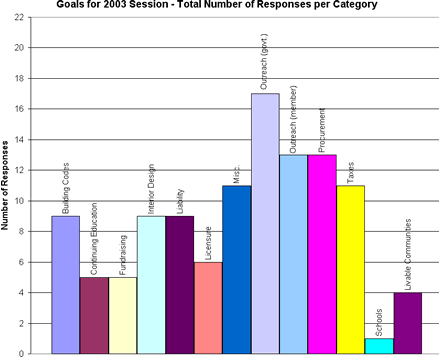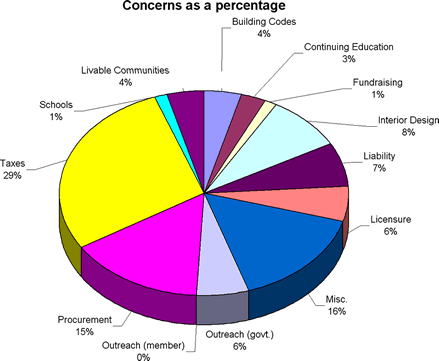
Knowledge, relationships, communications top state agendas
State Government Network (SGN) representatives reported in an annual survey that they are increasingly stepping up advocacy efforts, and that improving relationships between government officials and component membership tops their list of goals for the 2003 legislative session. The AIA’s Government Affairs team also found that tax-related issues are among the chief legislative concerns of the SGN representatives.
The AIA conducted the SGN survey for the third consecutive year in a continuing effort to spot national trends and help components share information and best practices. It compiled the results into the categories of goals, legislative and regulatory concerns, component activities, and working relationships.
The survey went to 53 SGN participants representing all U.S. states and territorities. A quarter of the respondents listed outreach as their single most important goal. The results were split between the 14 percent who specified outreach to government officials, and the other 12 percent who indicated that they wanted to focus their efforts on improving their communication/advocacy outreach efforts to their membership.
Twelve percent of respondents reported that they plan to beef up their work on procurement and government contracting issues to help architects expand their services, and 10 percent said they would closely monitor service taxes. Indeed, tax legislation was listed as the legislative issue that most concerns government affairs committees nationwide. Respondents report additional tax-increase proposals as states work to balance their budgets.
The components that responded to the survey have
active government affairs committees. The SGN representatives reported
that their components had presented written or verbal testimony to legislative
committees. At the high end, AIA Hawaii reported that it testified 25
times. On average, however, components offered testimony four times during
the 2002 legislative session. Nearly all the components listed reviewing
and adopting positions on relevant legislation as integral parts of their
activities, and:
• 87 percent reported that they both set government affairs programs
and utilized member action networks
• 74 percent said they adopted formal public policies
• 72 percent of the respondents worked with lawmakers to draft legislation
• 62 percent of respondents held a lobby day.
Working relationships
The survey, which had a 75 percent response rate, also tracked how state
components view allied organizations and the nature of their working relationships
with those groups, including engineers, general contractors, landscape
architects, school groups, building/property owners, disability groups,
building code groups, and local chambers of commerce. Overall, the top
three relationships were with engineers, general contractors, and landscape
architects. AIA staff and SGN representatives will use this information
to identify potential working relationships with other groups and improve
the strategic alliances that they have already developed.
Copyright 2003 The American Institute of Architects. All rights reserved.
![]()
| The next SGN meeting will be held March 7 at AIA headquarters in Washington, D.C. The State Government Network was created in 1991 as a tool for state components and their member-based government affairs committees to identify emerging and priority advocacy issues for architects. For more information about the SGN, contact Paul Mendelsohn, director, State and Local Affairs, 202-626-7388. You can also take advantage of the AIA’s Grassroots Annual Leadership and Legislative Conference March 5–8. The program offers the opportunity for your component leadership to learn about federal politics and legislative priorities. Encourage them to bring back tips on lobbying state and local lawmakers and share them with your colleagues at home. Click here to learn more about Grassroots. |
|

